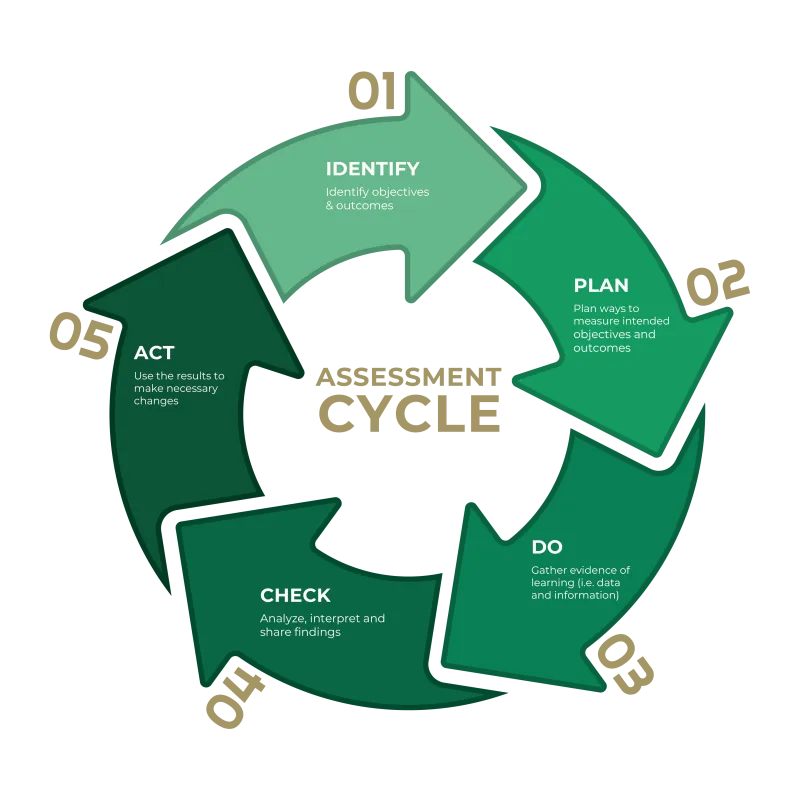ASSESSMENT TOOLKIT
Assessment is defined as “any [intentional, meaningful, coordinated] effort to gather, analyze, and interpret evidence, which describes institutional, divisional, or agency effectiveness” (Upcraft, 2003, p. 556). UNC Charlotte’s Division of Student Affairs define assessment as the ongoing collection and analysis of data which includes the systematic collection, analysis, and use of information to improve department and/or program effectiveness and/or student learning and development.
Assessment is not program review or evaluation. Program review or evaluation uses assessment data as part of a comprehensive evaluation of program or unit. Assessment is not research. Research seeks to test hypotheses or be generalized to populations outside UNC Charlotte. So why is assessment important? Upcraft and Schuh (2008) provide us with three essential reasons why assessment is important:
- Quality – assessment helps us improve
- Accountability – assessment helps us document and articulate our value and effectiveness
Affordability – assessment helps us determine and communicate both our educational and economic value

To facilitate continuous assessment by student affairs educators, we adhere to the Assessment Cycle. This framework guides the development, monitoring, and evaluation of program quality, enabling the identification of strengths and areas for improvement. Ultimately, this process drives program adjustments that enhance student learning. The Assessment Cycle comprises five distinct phases:
- Identify objectives & outcomes
- Plan ways to measure intended objectives & outcomes
- Gather evidence of learning (i.e., data & information)
- Check your findings (i.e. analyze, interpret, & share findings)
- Act on your results (i.e. make necessary changes)
To facilitate effective assessment practices, the Division of Student Affairs provides resources to support staff during each phase of the assessment cycle.
1: Identify Objectives & Outcomes
In student affairs, it's crucial to define what we want students to gain from their experiences before we design how we will measure those gains. Clearly written objectives and student learning outcomes act like a roadmap, ensuring our assessments accurately capture the skills, knowledge, and attitudes we aim to develop in students. For example, if we want students to improve their leadership skills, we need to define what "improved leadership" looks like before we try to assess it. This not only helps us create relevant assessments but also guides the design of our programs and services, making sure they are actually helping students achieve those desired outcomes. It keeps everything we do focused and intentional, maximizing our impact on student development.
- Assessment Key Terms and Definitions
- What are Student Learning Outcomes?
- The Need for Program Theory and Implementation Fidelity in Student Affairs Assessment
- Student Learning Outcomes in Student Affairs
- Characteristics of Student Learning Outcomes
- Student-Centered Assessment Checklist
- Writing Student Learning Outcomes via the ABCD method
- Launching and Sustaining Assessment Plans & Projects
- What are Operational Outcomes?
2: Plan ways to Measure Objectives & Outcomes
In student affairs assessment, it's essential to carefully align what we want students to learn (outcomes) with how we measure that learning (measures). This ensures the data we collect actually tells us if students are developing the intended skills and behaviors. By directly connecting outcomes to assessment tools, we get a clear picture of our programs' effectiveness, allowing us to make informed decisions about how to improve them and ultimately better support student success.
- Matching Verbs to Assessment Instruments
- Types of Instruments
- What is Qualitative Assessment & When to Use it
- Inductive vs Deductive Approaches to Qualitative Assessment
3: Gather Evidence of Learning (i.e., data & information)
Before any analysis or interpretation can occur, it is essential to: Gather Evidence of Learning (i.e., data & information). This crucial step involves collecting relevant data and information to understand student outcomes.
- Survey Checklist
- Survey Fatigue
- Focus Groups
- Rubrics Uncovered: Everything You Need to Know
- Advantages & Disadvantages of Rubrics
4: Check your Findings (i.e., analyze, interpret, & share findings)
Analysis and interpretation turn raw data into actionable insights, revealing patterns in student learning and program effectiveness. This allows student affairs professionals to understand why results occur and make data-driven decisions that enhance student success.
- Student Learning Outcomes aligned with Appropriate Analyses
- Inductive vs Deductive Approaches to Qualitative Assessment
- Coding Checklist
5: Act on your Results (i.e., make necessary changes)
Acting on your results or "Closing the loop" is a key concept in student affairs assessment, referring to the process of using data to inform and improve practice. It means that after collecting and analyzing assessment data, the insights gained are used to make informed decisions moving forward. This is crucial because assessment should always be a tool for continuous improvement. By closing the loop, student affairs educators can enhance student learning, strengthen programs and services, inform planning and budgeting, contribute to student and staff success, and ultimately improve retention and graduation rates, while also supporting successful accreditation and program reviews.